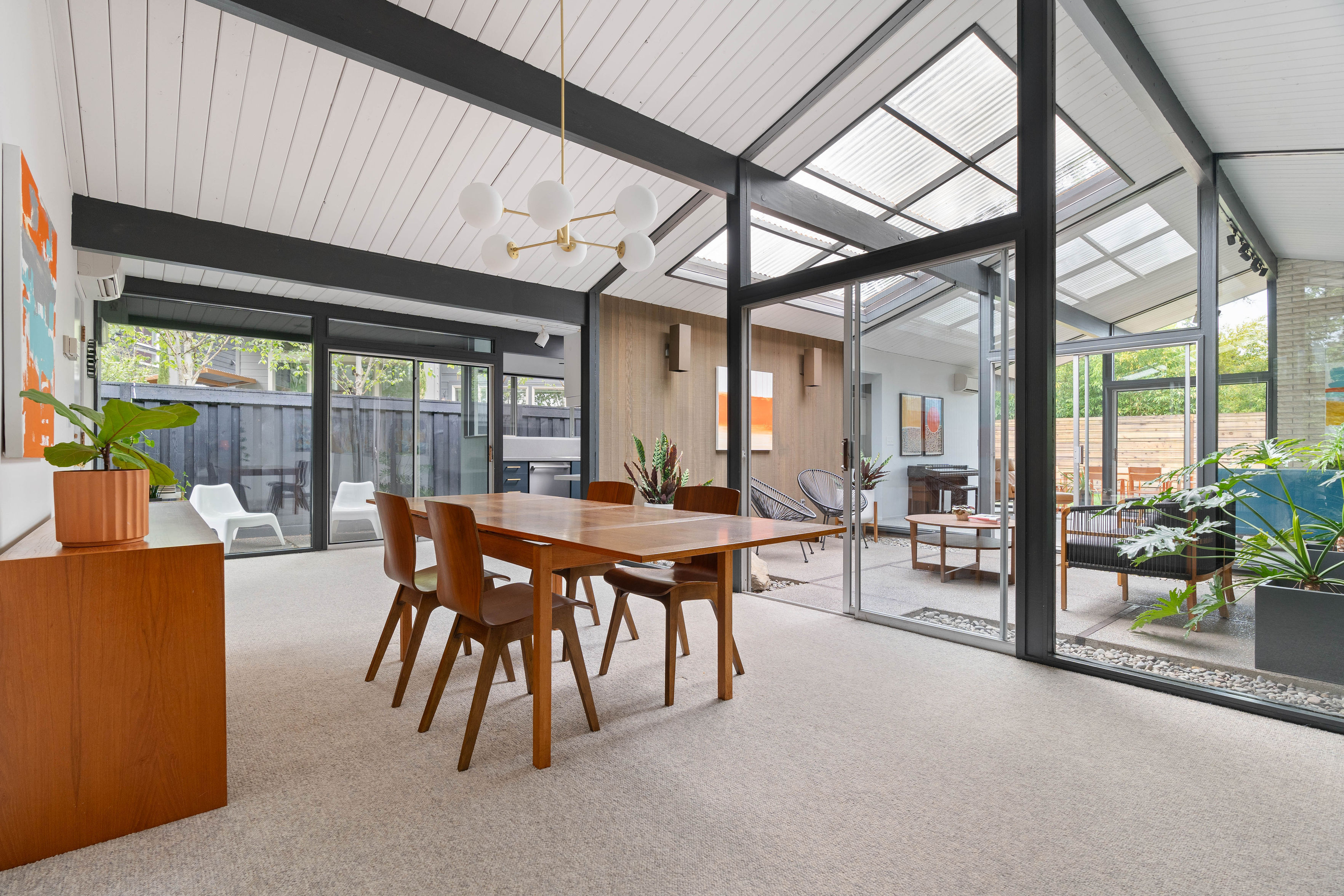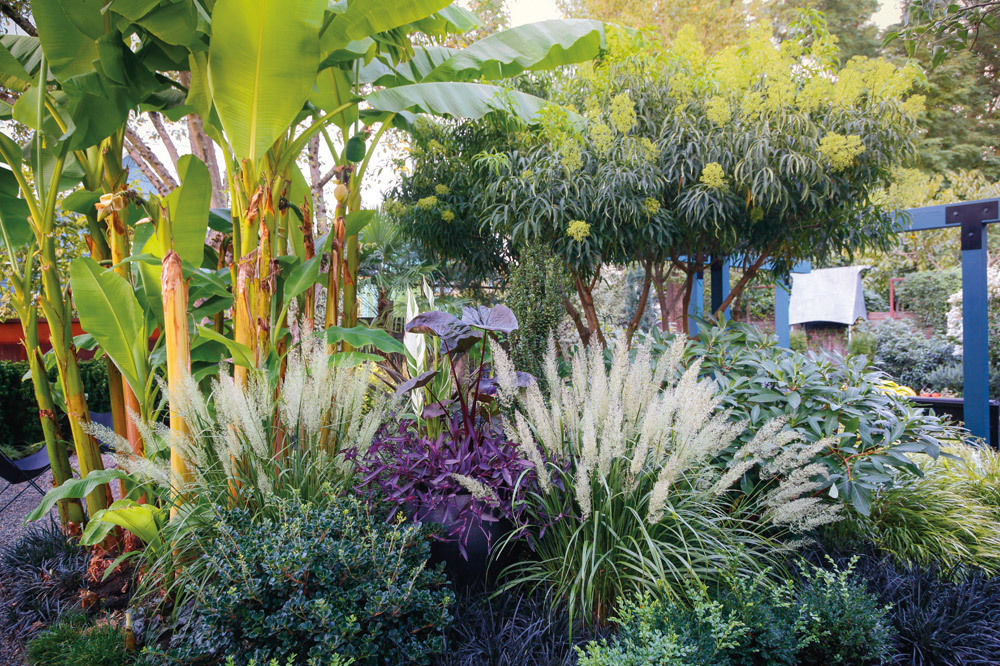
A Dazzling Portland Garden with Tropical Flair
A garden is never finished. In the words of landscape historian Mac Griswold, it is “the slowest of the performing arts.” Lauren Hall-Behrens would agree—over the past decade, she’s staged a quiet drama in her Northeast Portland garden.
When she graduated from the Evergreen State College in Olympia, Hall-Behrens didn’t know the landscape design profession existed. Armed with a liberal arts degree and an avid interest in psychology and sculpture, she moved to Portland to work as a color consultant and carpenter’s assistant. She began to notice how powerfully spaces can affect people, and grew enamored with landscape design after some conversations with practicing designers. She signed up for classes at Portland Community College, found a professional mentor, and launched her own business, Lilyvilla Gardens, in 2003.
Her most demanding teacher to date has been her own garden. The run-down, 60-by-100-foot corner lot in Northeast Portland she moved to in 2001 came with the heavy, compacted soil of inner-city neighborhoods, plus flat topography, very little privacy, and overgrown trees. Hall-Behrens began to transform the debris-strewn space into an entrancing, tropical paradise that provides a striking foil for the surrounding busy urban neighborhood.
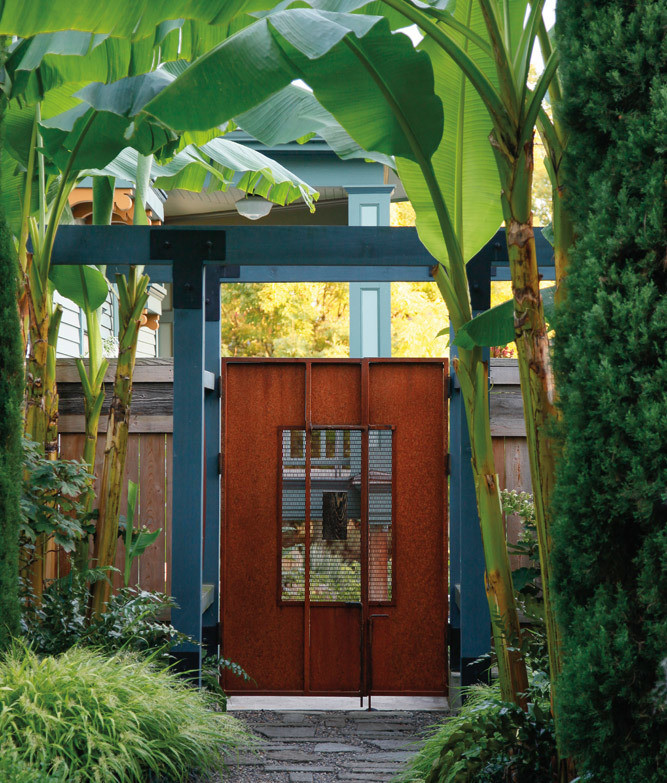
Image: Joshua McCullough
“The strongest projects occur when my client and I come up with a concept that has emotional resonance,” she says. “In the case of my own garden, my fundamental, practical need was for a calm space with structure in winter.”
Given her “very tall house,” she knew it would be important to infuse the outdoor space with architectural features to instill balance between home and garden. To that end, she designed a hefty gate set in a frame stained the same blue-green as her home’s trim: a contemporary take on a ceremonial Japanese gate. Passage through its brawny doors marks a transition into an intimate space, and a pergola—again, stained blue-green—rises above the patio just beyond the house’s back steps, providing a sense of partial enclosure. A quaint, zinc-coated steel hut, sized for two, sits along the east fence. Other resting spots abound: modern mesh seats in a spacious gravel patio in the garden’s back corner, two clean-lined divans under the pergola in the central patio, and casual seats perched above the garden on the porch.
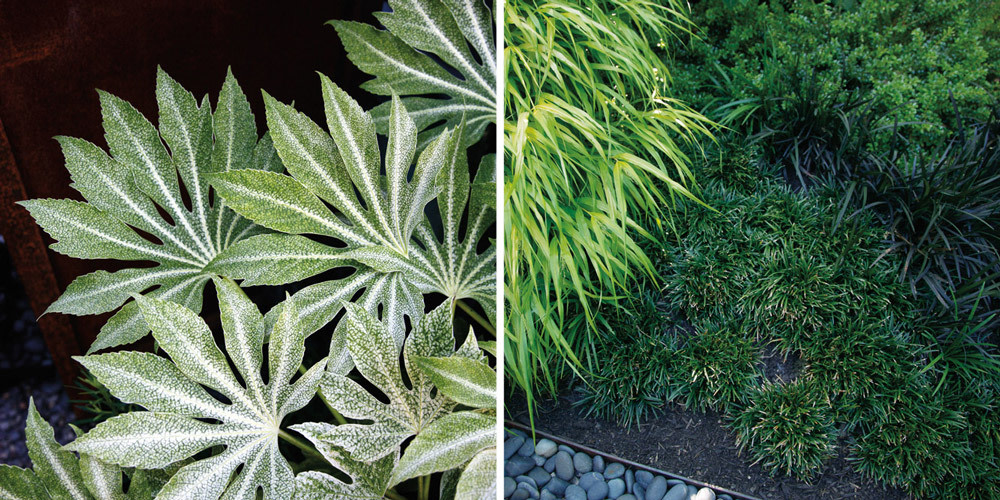
Image: Joshua McCullough
A semiformal, tropical motif comes to life in Hall-Behrens’s plant selection. Just inside the main gate, immense leaves of cold-hardy banana (Musa basjoo) draw the eyes upward, grounding the house while creating a sense of being dwarfed by nature’s fecundity—at least from late July to October, when the bananas stretch to their full height and magnificence. Formal planters filled with exuberant Astelia spikes and dripping with silvery dichondra flank the back steps, extending the hot-climate vibe. “Many Asian tropical gardens have statues or other matching formal elements serving as a kind of ‘call to entry’ at doorways and passages,” explains Hall-Behrens. She embraces other motifs from formal tropical gardens around the world, like symmetry, low evergreen hedges, and uniform swaths of low ground covers. Classic Southern plants with personal resonance (Hall-Behrens grew up in Texas and Oklahoma) have also made their way into the garden, including mondo grass, star jasmine, and crape myrtle. Evergreen plants provide a steady backdrop for the more charismatic plant performers, with their voluptuous bursts of growth, blossoms, seed heads, and seasonally shifting colors.
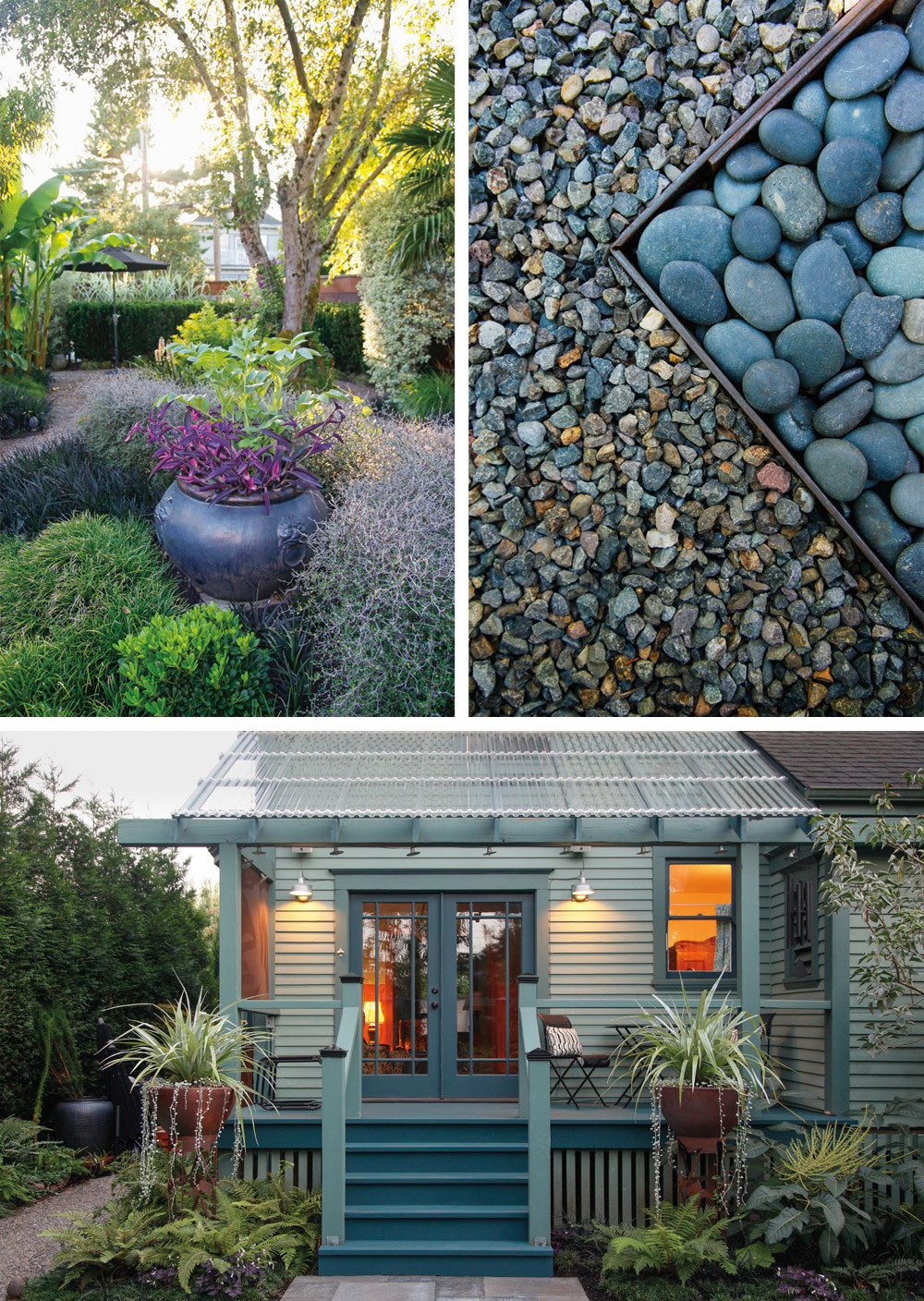
Image: Joshua McCullough
Themes of compression and release establish dynamic rhythms throughout the garden. “Changes in flow patterns slow passage through a small urban garden, which is essential—or else you’re done in 30 seconds,” says Hall-Behrens. Ample paths spill into wide-open areas. Dramatic focal points and clever view corridors make the small space feel expansive. Contrasting textures draw attention to details. The large, paddle-like leaves of nicotiana rise from pools of wispy grasses. Jagged, shiny acanthus and holly fern set off the giant, matte-rumpled foliage of hardy banana. Smooth, rounded stones break up the space between wide gravel paths and the gray squares of the stone terrace.
Generally, designers can occasionally step back from a project, to see it with fresh and unencumbered vision. When you’re designing your own space, Hall-Behrens notes, that freedom vanishes. “You develop such an emotional connection to the site and individual plants,” she says. “I saw my own garden with overly critical eyes for a long time.” Over the years, though, she has simplified the garden to distill the urges that drove her original design.
“Now, my relationship with the garden is one of understanding,” she says. “I’m less critical. I still see things I want to change, but I am confident of my vision.” The props, the backdrop, and even the main characters may shift over time—but the drama continues to unfold, with new plot twists each year.
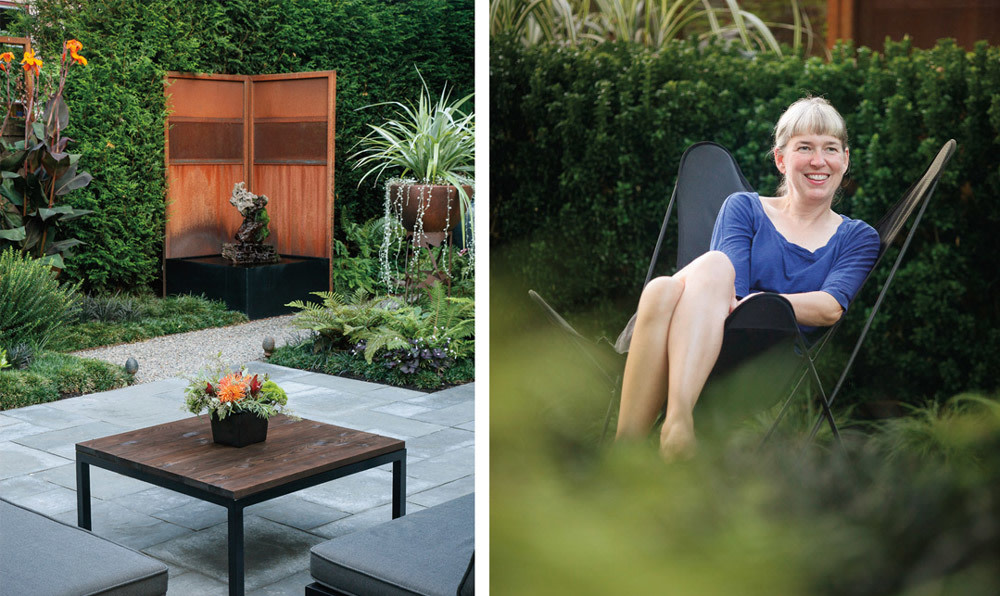
Image: Joshua McCullough
LAUREN’S PLANT PICKS
Calamagrostis brachytricha (Korean feather reed grass): This grass has some heft but doesn’t flop like many grasses that grow in partial shade. Great as a specimen or in groupings, it has incredible, six-inch-long, fluffy pinkish flowers that hold their form through the winter.
Hydrangea quercifolia Syke’s Dwarf, Snow Queen (Oakleaf hydrangea): Glorious, creamy flowers of early summer have a lightly spiced, powdery fragrance; fall brings claret to burgundy-red foliage, which reveals cinnamon-colored, exfoliating bark until it drops. “I tend to use it in transitional places, between sun and shade, to lighten up a broadleaf evergreen palette and provide contrast with its larger leaf,” says Hall-Behrens.
Azara microphylla (Boxleaf Azara): This gorgeous little tree has tiny, deep-green leaves and minuscule, fragrant late-winter flowers that smell of chocolate and vanilla. In urban settings, Azara provides a light, airy privacy screen. It’s mostly cold-hardy, with only rare frost damage to the bark.
Ophiopogon japonicus Nana (Dwarf mondo grass): Fully evergreen, the dark foliage of dwarf mondo grass looks fantastically fresh throughout the winter, and the slender, shiny leaf blades create wonderful pools of texture on the ground. It’s slow growing but eventually forms a lush mat of grassy foliage.
Epimedium x omeiense (Fairy wings): This evergreen has a leathery, reddish-brown-mottled leaf with tall, wiry stems. Airy sprays of late-winter and early-spring flowers are white and burgundy, like tiny fairy wings.

